8+ Sample Contingency Sales Plan
-
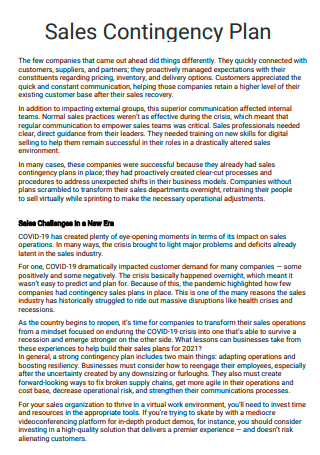
Contingency Sales Plan Template
download now -
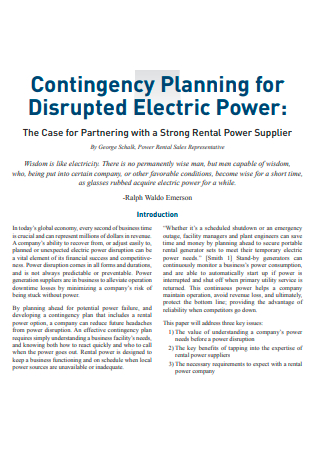
Contingency Electric Power Sales Planning
download now -
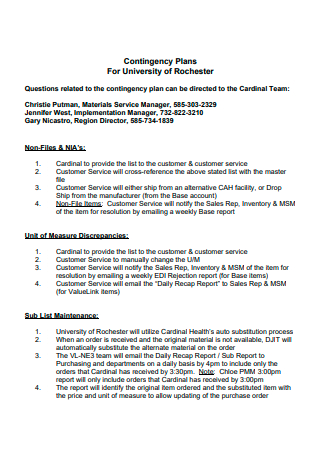
Basic Contingency Sales Plan
download now -
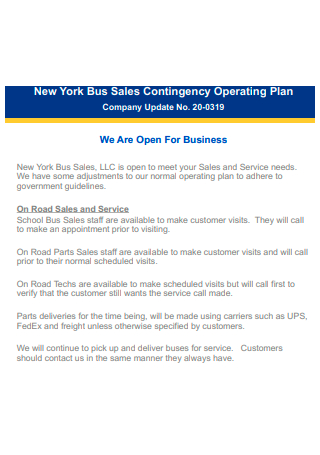
Contingency Sales Operating Plan
download now -
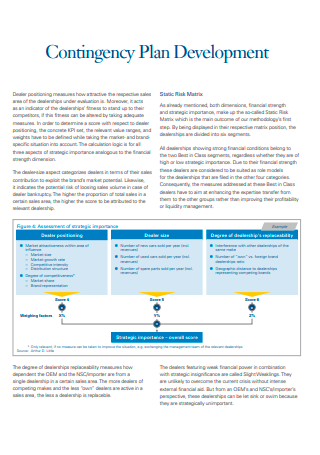
Contingency Sales Plan Development
download now -
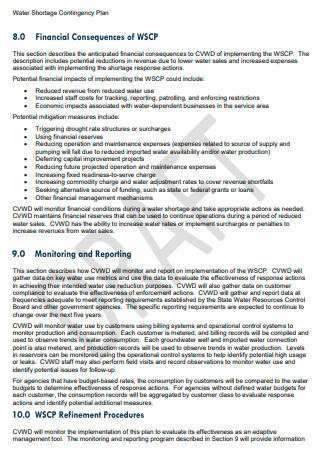
Draft Contingency Sales Plan
download now -
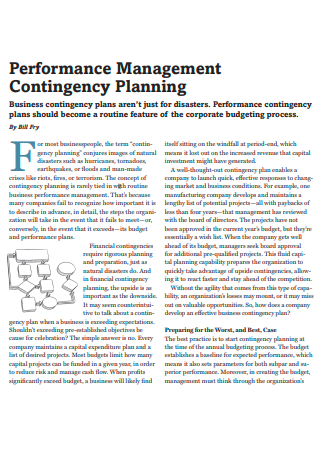
Performance Management Contingency Sales Planning
download now -

Contingency Sales Strategy Plan
download now -
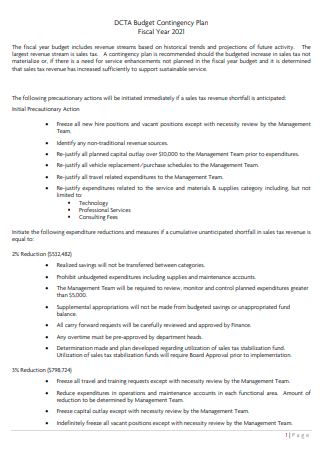
Budget Contingency Sales Tax Plan
download now
FREE Contingency Sales Plan s to Download
8+ Sample Contingency Sales Plan
What Is a Contingency Sales Plan?
Benefits of a Contingency Plan
How to Create a Contingency Sales Plan
FAQs
What are some of the types of contingency plans?
How to ensure the effectiveness and success of the contingency sales plan?
What are the best ways to react when there is a global crisis?
What Is a Contingency Sales Plan?
A Contingency Sales Plan is an initiative in the sales planning process of the business in preparation for any inadvertent negative circumstances that could affect its sales operation and business processes. It is a planning process that offers alternative sales strategies to counter, prevent, or to mitigate the impact of an impending crisis or a disaster. Sometimes incorporated as part of the business plan, a contingency sales plan is what you call as a backup planning in its simplest terms. Usual events where a contingency sales plan is being implemented is in the case of risk-related incidents such as fire, and force of nature incidents such as an earthquake, typhoon, and in our example, the current pandemic. Threats to cyber security such as a cyberattack can also be considered as a risk scenario. Sales continuity and recovery is the main aim of a contingency sales plan. The plan seeks to prepare well-researched plans, maximize and utilize appropriate resources, and to protect the customer experience from being inadvertently affected as well.
Benefits of a Contingency Plan
It’s always good to have a “Plan B”. The 2020 pandemic proved this point when businesses scrambled to look for the options to keep them floating, none the wiser of the effect that the pandemic has brought. The impact was felt globally, needless to say economically, and the chain of events led to the closure or to the halt of one business trade to another. The need for a backup plan in this circumstance has never been greater. For those businesses who have a Plan B right from the start are reaping the benefits and advantages of having a backup plan. Below are some of the benefits of having a contingency plan in place.
How to Create a Contingency Sales Plan
No one could predict when a crisis or a disaster would hit, or if when it does happen, the level of effect it would have on the business, most especially on the business’s sales revenue. The best thing to do is to prepare for all scenarios by creating fall back structures or contingency sales plans. These plans should be able to address any possible events through alternative ways in doing sales despite the ongoing crisis, or immediately after a disaster took place. Since a company’s existence depends on its revenue stream, it is a must that a contingency sales plan should be part and parcel when planning for a company’s operation. Here are the common steps taken when creating a contingency sales plan.
Step 1: Identify the possible risk circumstances
Create a table for your contingency sales plan. Make a list of all the different possible circumstances that could affect the business and sales process. List them down in one column, identifying each specifically. Examples would be earthquake, flood, typhoon, fire, power outage, lack of manpower, shortage in supplies, accidents or injuries in the workplace, lack of transportation, and so on.
Step 2: Do a risk analysis
In the next column, determine the level of severity of the risk for each circumstance. These severity levels pertain to the impact the circumstances will have on the sales process, whether it’s low, medium or high, or which are the most important risks to focus on and which are the least important ones. These would guide you later on when formulating the contingency sales plan action steps. The high severity level would entail a more aggressive sales strategy approach, while a low severity level probably wouldn’t need a contingency plan. You could do a business impact analysis as well to analyze the overall impact on the delivery and the recovery time.
Step 3: Creating contingency sales action plans
Based on the risk scenarios and risk analysis, start creating your alternative sales action plans with the goal of preventing or minimizing the impact on the sales revenue. In the case of a natural disaster, normal sales strategies are put to a halt, thereby impacting the overall business revenue. A contingency sales action plan in this case in continuing sales operation is through strengthening the online marketing presence of the business before any crisis or disaster even happens. Part of the sales strategies is that it should already develop and improve its online purchase and delivery services, so that in the likely event that customers could not go to a physical store due to an impending calamity, there is an alternative option for them. Another alternative plan is to have a contingency sales fund. This is to ensure that there will still be money to fund the continuity of marketing strategies and sales operations once the crisis or the disaster is over, or to use it as a recovery fund if needed due to loss of revenue. Advance purchase of laptops and softwares needed for remote work setup is also another example of a contingency sales action plan. Adopting a crisis communication plan and a workplace emergency plan could also constitute a contingency sales action plan.
Step 4: Assigning the contingency sales plan
Next is to assign each contingency sales action plan to individuals who will be responsible in carrying them out when the need arises. These individuals should have the right skills and capacity in performing these responsibilities, and they need to make a regular update report to their heads on the progress for each action item they’re assigned to.
Step 5: Monitor and update
There should be continuous monitoring and regular updates and feedback given for each contingency sales plan. This is to validate the effectiveness of the plans, and to make some necessary adjustments or changes if needed to make these plans more successful.
FAQs
What are some of the types of contingency plans?
Usual common types of contingency plans are investment positioning, asset protection, business continuity, and cyber security. Investment positioning is that business owners availed themselves of strategies that would avoid, or mitigate, the impact of a financial loss due to a negative event. An example would be companies would avail of insurance as a way of protection, and at the same time, having the option of investment through portfolio diversification, just like in a variable insurance. Asset protection could come in the form of purchasing additional assets, whose purchase is justified when the threatening circumstances happen that necessitates the use of such assets. Business continuity is the most common type of contingency sales plan. These are the continuity and recovery process plans created at the start of the company’s operation. Cyber security contingency plans are nowadays a top priority for security risk since almost all business processes are done online. Contingency plans to ward off cyber attacks could come in the form of purchasing the latest software or technology against hacking threats or viruses,or regular maintenance of software technology.
How to ensure the effectiveness and success of the contingency sales plan?
No one really knows the depths of the impact or how long a crisis or a disaster will last. To ensure the effectiveness and success of a contingency sales plan, make sure that, first of all, the plans made are well-researched and measurable. Well-researched, meaning there is a solid ground of research where the action plan is based off. An example would be past data figures from other industries who have gone through a similar circumstance, and the resources and action items they’ve implemented to carry themselves through successfully. Another way of ensuring a successful contingency sales plan is to have well-defined, realistic and achievable sales strategies. These strategies are usually short-term in nature, and created in anticipation of a crisis or a disaster.
What are the best ways to react when there is a global crisis?
As a business owner, the first thing you need to do is to reassure your employees and your customers that there is a team managing the crisis, and that for the end-customers, the company will do its best to resume its services and operations. Next is to have ongoing and consistent communication with your customers, suppliers, and investors as a way of reassuring them. This will also help build up further their trust and loyalty they have for your business. Start implementing contingency measures, or looking for ways to adapt to the current situation, such as doing remote working setup, migrating to online business processes, streamlining work processes and doing away with redundant and obsolete tasks, et cetera. Last, but not least, is constant monitoring of the global crisis. In order for your business to survive, you should be able to anticipate in advance how the market or the economy reacts and recover as well from the global crisis so that your contingency plans can become more measurable.
It was indeed a mad scramble to adapt and to regain normalcy in the pandemic situation. Businesses who had a Plan B got a good head start in surviving the situation. For those businesses who were caught off-guard and without any backup plan, they were faced with the most challenging task of how to stay afloat and continue their operation, or to face the music and shut down their business. This situation all the more strengthened the significance of having a contingency sales plan as part of any business operation process. The business’s biggest adversary comes in the form of being caught unaware and unprepared when negative circumstances, such as the pandemic or any negative unforeseen events, happens and hits them hard where it really hurts: their income revenue stream.
Want to know how to ensure that your business will survive and continue running despite any kind of crisis or disaster? Check out our contingency sales plan template. It’s easy to fill out, follow through, and it will serve as your roadmap for those impending crises in the making. Download one now, and start making plans to protect your business’s future!
